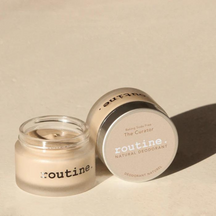Posted by Deena A. on 20th Sep 2024
Switch To Natural Deodorant (Part 2)
In a previous blog, we talked about why sweating occurs and the chemical debate. Now we are discussing the lymphatic system, explore the advantages of cream deodorants, and some helpful tips you may not have thought of.
The Lymphatic System and Natural Deodorants
The lymphatic system is a crucial part of the body's immune system, responsible for maintaining fluid balance, filtering out toxins, and transporting white blood cells to fight infections. It consists of a network of lymph nodes, vessels, and lymph fluid.
Here's how it works:
- Fluid Balance: The lymphatic system collects excess fluid (called lymph) from tissues and returns it to the bloodstream, preventing swelling and maintaining the balance of bodily fluids.
- Immune Defense: Lymph nodes act as filters, trapping bacteria, viruses, and other harmful substances. White blood cells within the lymph nodes then destroy these pathogens, protecting the body from illness.
- Waste Removal: The lymphatic system also helps to remove waste products and toxins from the body, ensuring that they are processed and excreted.
Why Natural Deodorants are a Healthier Choice
Natural deodorants are often considered a healthier choice for several reasons, especially concerning the lymphatic system:
1. No Harmful Chemicals: Conventional deodorants and antiperspirants often contain chemicals like aluminum, parabens, and synthetic fragrances. These chemicals can clog sweat glands, potentially disrupting the natural detoxification process of the lymphatic system. Over time, this may lead to the accumulation of toxins in the body.
2. Support Natural Detoxification: Sweating is a natural way for the body to release toxins. Natural deodorants allow the body to sweat naturally without blocking sweat glands. This supports the lymphatic system in its role of detoxification and helps maintain overall health.
3. Reduced Risk of Irritation: Natural deodorants are generally made with gentle, non-toxic ingredients, reducing the risk of skin irritation or allergic reactions. This is particularly important for sensitive areas like the underarms, where lymph nodes are located.
If you do experience irritation with natural deodorants, keep reading! It may be due to baking soda...
4. Better for Long-Term Health: By avoiding harsh chemicals and supporting the body's natural processes, natural deodorants may contribute to better long-term health, particularly in reducing potential risks associated with chemical exposure.
Overall, natural deodorants align with the body's natural functions, including the lymphatic system's role in detoxification and immune defense, making them a healthier choice for daily use.
Helpful Tip!
A great habit when using any deodorant is using a salt scrub or detox scrub on your underarm. Sweat itself doesn’t actually smell. But what does smell is bacteria on our skin mixed with the sweat. Give your pits some attention everytime time you shower.
Females LISTEN UP
We have been told numerous times about doing breast self exams. Well here is a great opportunity to do this exam everyday if you are using cream deodorant. While applying do a quick breast exam either in the shower when you use your scrub or as you are applying the deodorant.
Applying Cream Deodorant
Step 1: Take a pea sized amount from the container with a small spatula or your finger (back scoop with your nail if they’re long).
Step 2: Rub the cream deodorant onto your clean armpit.
Step 3: If you have access that won’t rub in, apply it anywhere on your body! Your feet, between your thighs, nape of neck, and your underboobs are all great places to enhance your smell.
Pro Tip for Routine Stick Users: Dab the deodorant onto your armpit, don’t rub. Rubbing will apply too much product.
A Note About Baking Soda and Deodorant
By Routine
“Despite being an incredible natural ingredient that is a powerhouse at absorbing odors, baking soda is more alkaline than our bodies so in rare instances it can throw off pH balance in some people. Our classic formulas do have reduced baking soda levels so we find 9/10 baking soda sensitive people are able to use our classic formulas.
A baking soda reaction can manifest in a variety of symptoms ranging from redness and itchiness to a visible rash. In rare instances it can even affect skin pigmentation (a darkening of skin in the armpit area). These reactions can crop up every now and again due to changes in the body (hormones) and the environment (cold, dry weather). They come and go in some people while others can't tolerate baking soda at all.
For this reason, we developed a full line of baking soda free scents to keep even the most sensitive pits feeling fresh! This formula uses dietary magnesium instead of baking soda, and has soothing qualities that have helped many armpits through the discomfort of a baking soda sensitivity.
Some people find that taking a small break from baking soda is enough and they are able to start using their baking soda formula again once the symptoms pass. Others do switch over to the baking soda free formula permanently. If you are requiring immediate relief from a baking soda sensitivity, you can try blotting something acidic onto the site, such as apple cider vinegar to help the pH balance.”
The Fine Print
Please note that we are not experts on these topics. We are basing our answers on research and personal experience. Any natural health product may cause serious adverse reactions or interactions with other medications or natural health products. Read the label, warnings and inserts provided by the manufacturer and consult your healthcare professional if you are unsure if a product is right for you. No health, wellness, prescription or pharmaceutical information is intended to substitute for the diagnosis, treatment and advice of a healthcare professional.
Resources
- https://www.goodrx.com/well-being/alternative-treatments/the-benefits-of-moving-to-aluminum-free-more-natural-deodorants-and-perspirants
- https://time.com/4394051/deodorant-antiperspirant-toxic/
- https://www.goodrx.com/health-topic/environmental/what-are-parabens
- https://www.unep.org/who-we-are/about-us
- https://www.unep.org/explore-topics/chemicals-waste/what-we-do/emerging-issues/endocrine-disrupting-chemicals
- https://www.ncbi.nlm.nih.gov/pmc/articles/PMC8834979/#:~:text=Like%20many%20other%20EDCs%2C%20paraben,development%20in%20boys%20%5B30%5D.
- https://www.fda.gov/consumers/consumer-updates/5-things-know-about-triclosan
- https://www.ncbi.nlm.nih.gov/pmc/articles/PMC6126357/
- https://www.goodrx.com/health-topic/womens-health/phthalates-health-hazards
- https://www.ncbi.nlm.nih.gov/pmc/articles/PMC5783668/
- https://pubmed.ncbi.nlm.nih.gov/23168567/
- https://www.ewg.org/news-insights/news/cheatsheet-phthalates
- https://www.goodrx.com/well-being/alternative-treatments/the-benefits-of-moving-to-aluminum-free-more-natural-deodorants-and-perspirants.
- https://routinecream.ca/a/faq?srsltid=AfmBOor40DZikinDj9I1vXO-YO_gdNq9GxwRVniKCUH2d9L_hHUN5WfO

